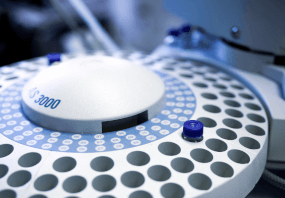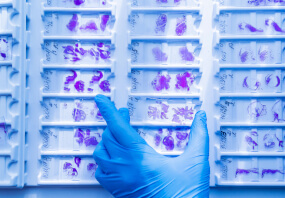General description
Epithelial cell adhesion molecule (UniProt: P16422; also known as Ep-CAM, Adenocarcinoma-associated antigen, Cell surface glycoprotein Trop-1, Epithelial cell surface antigen, Epithelial glycoprotein, EGP, Epithelial glycoprotein 314, EGP314, hEGP314, KS 1/4 antigen, KSA, Major gastrointestinal tumor-associated protein GA733-2, Tumor-associated calcium signal transducer 1, CD326) is encoded by the EPCAM (also known as GA733-2, M1S2, M4S1, MIC18, TACSTD1, TROP1) gene (Gene ID: 4072) in human. EpCAM is single-pass type I membrane monomeric protein that may act as a physical homophilic interaction molecule between intestinal epithelial cells and intraepithelial lymphocytes at the mucosal epithelium for providing immunological barrier as a first line of defense against mucosal infection. EpCAM is synthesized with a signal peptide (aa 1-23), which is subsequently cleaved off to generate the mature form that contains an extracellular domain (aa 24-265), a short transmembrane domain (aa 266-288), and the cytoplasmic domain (aa 289-314). It plays a role in embryonic stem cells proliferation and differentiation. It is selectively expressed by undifferentiated cells and its levels decline rapidly upon embryonic stem cell differentiation. Its expression is observed in almost all epithelial cell membranes, but not on mesodermal or neural cell membranes. EpCAM is reported to be essential for carcinogenesis in numerous types of human cancer. It is shown to be expressed on the surface of adenocarcinoma. On carcinoma tissue it is found in a hyperglycosylated state. Glycosylation at asparagine 198 is shown to be essential for its stability. In murine models, clone EpMab-16 is reported to exerts antitumor activity on colorectal adenocarcinoma and significantly reduces tumor growth in oral squamous cell carcinoma. Mutations in EPCAM gene have been linked to hereditary non-polyposis colorectal cancer 8 that is characterized by a familial predisposition to early-onset colorectal carcinoma and extra-colonic tumors of the gastrointestinal, urological, and female reproductive tracts. (Ref.: Hosono, H., et al. (2020). Oncol. Lett. 20(6); 383; Kaneko, MK., et al. (2020). Oncol. Rep. 44(6); 2517-2526; Lu, TY., et al. (2010). J. Biol. Chem. 285(12); 8719-8732).
Specificity
Clone EpMab‑16 is a mouse monoclonal antibody that detect Human EpCAM.
Immunogen
CHO-K1 cells transfected with pCAG/EpCAM‑PA tag.
Application
Quality Control Testing
Evaluated by Western Blotting in CHO-K1 cells overexpressing Human EpCAM.
A 1:1,000 dilution of this antibody detected EpCAM in lysate from CHO-K1 cells overexpressing Human EpCAM, but not in untransfected cells.
Tested Applications
Western Blotting Analysis: A representative lot detected EpCAM in Western Blotting applications (Kaneko, M.K., et al. (2020). Oncol Rep. 44(6):2517-2526; Hosono, H., et al. (2020). Oncol Lett. 20(6):383).
Inhibition Assay:: A representative lot of this antibody inhibited tumor growth in oral squamous cell carcinoma (HSC-2) xenograft model mice. (Kaneko, M.K., et al. (2020). Oncol Rep. 44(6):2517-2526.
Immunohistochemistry Applications: A representative lot detected EpCAM in Immunohistochemistry applications (Kaneko, M.K., et al. (2020). Oncol Rep. 44(6):2517-2526; Hosono, H., et al. (2020). Oncol Lett. 20(6):383).
Flow Cytometry Analysis: A representative lot detected EpCAM in Flow Cytometry applications (Kaneko, M.K., et al. (2020). Oncol Rep. 44(6):2517-2526; Hosono, H., et al. (2020). Oncol Lett. 20(6):383).
Note: Actual optimal working dilutions must be determined by end user as specimens, and experimental conditions may vary with the end user
Anti-EpCAM, clone EpMab‑16, Cat. No. MABT1587, is a mouse monoclonal antibody that detects EpCAM and is tested for use in Flow Cytometry, Immunohistochemistry, Inhibition Assay, and Western Blotting.
Physical form
Purified mouse monoclonal antibody IgG2a in PBS without azide.
Storage and Stability
Store at -10°C to -25°C. Handling Recommendations: Upon receipt and prior to removing the cap, centrifuge the vial and gently mix the solution. Aliquot into microcentrifuge tubes and store at -20°C. Avoid repeated freeze/thaw cycles, which may damage IgG and affect product performance.
Other Notes
Concentration: Please refer to the Certificate of Analysis for the lot-specific concentration.
Disclaimer
Unless otherwise stated in our catalog or other company documentation accompanying the product(s), our products are intended for research use only and are not to be used for any other purpose, which includes but is not limited to, unauthorized commercial uses, in vitro diagnostic uses, ex vivo or in vivo therapeutic uses or any type of consumption or application to humans or animals.
- UPC:
- 41106300
- Condition:
- New
- Availability:
- 3-5 Days
- Weight:
- 1.00 Ounces
- HazmatClass:
- No
- MPN:
- MABT1587-25UG












